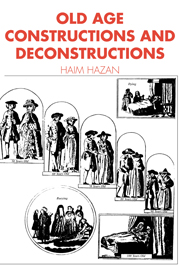Book contents
- Frontmatter
- Contents
- Acknowledgements
- Introduction: towards knowledge of old age
- PART I REPRESENTATIONS OF AGEING: LANGUAGES ABOUT OLD AGE
- PART II PRESENTATIONS OF AGEING: LANGUAGES OF THE OLD
- 5 Control: the social boundaries of age
- 6 Meaning: the cultural boundaries of life
- 7 Another universe: time, space, and self
- Conclusions: the nature of knowledge about ageing
- Notes
- Bibliography
- Index
6 - Meaning: the cultural boundaries of life
Published online by Cambridge University Press: 05 June 2012
- Frontmatter
- Contents
- Acknowledgements
- Introduction: towards knowledge of old age
- PART I REPRESENTATIONS OF AGEING: LANGUAGES ABOUT OLD AGE
- PART II PRESENTATIONS OF AGEING: LANGUAGES OF THE OLD
- 5 Control: the social boundaries of age
- 6 Meaning: the cultural boundaries of life
- 7 Another universe: time, space, and self
- Conclusions: the nature of knowledge about ageing
- Notes
- Bibliography
- Index
Summary
Every society has its own particular images of human life. In some mythologies the life of a human being is described in terms of the image of a snake biting its own tail or a dragon swallowing itself (see Eliade 1967). In a classic riddle put to Oedipus, man is described as a creature that crawls on all fours and then walks on two legs and finally on three. These different images manifest both a process, the life course, and a cycle – eternal return, ashes to ashes, dust to dust, the circadian rhythms of body time, the reiteration of festivals and daily routines. The constant interplay between the meaning we attach to the progressive flow of time and the omnipresence of cyclical time constitute two dimensions of human life which may be termed ‘course’ and ‘cycle’ respectively.
There are two principal ways of understanding the human life course or cycle: by examining it as a structure made up of different stages and by focusing on one point in time from which situations and contexts can be identified and interpreted. The first of these perspectives may be compared to a map of the life journey. It determines in advance not only the course of a life but also its critical choices. This approach is somewhat simplistic in its attribution of a universal character to life stages, ignoring motivation, personal world view, and specific circumstances.
- Type
- Chapter
- Information
- Old AgeConstructions and Deconstructions, pp. 64 - 73Publisher: Cambridge University PressPrint publication year: 1994



